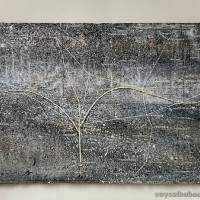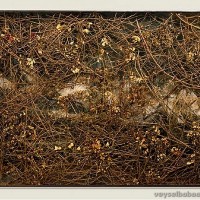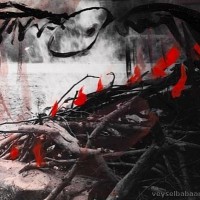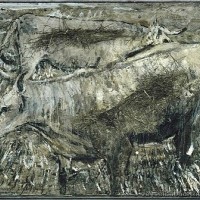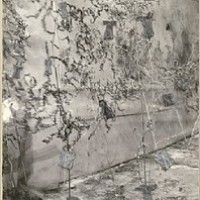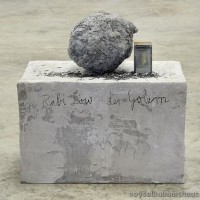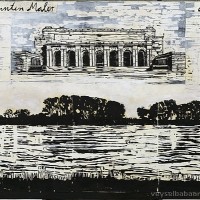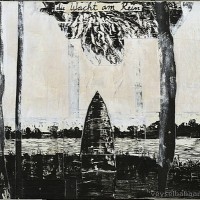- Home
- ABOUT US
- ABOUT VEYSEL BABA
- REDFOX ART HOUSE VIRTUAL TOUR
- MY LAST WILL TESTAMENT
- NOTES ON HUMANITY AND LIFE
- HUMAN BEING IS LIKE A PUZZLE WITH CONTRADICTIONS
- I HAVE A WISH ON BEHALF OF THE HUMANITY
- WE ARE VERY EXHAUSTED AS THE DOOMSDAY IS CLOSER
- NO ROAD IS LONG WITH GOOD COMPANY
- THE ROAD TO A FRIENDS HOUSE IS NEVER LONG
- MY DREAMS 1
- MY DREAMS 2
- GOLDEN WORDS ABOUT POLITICS
- GOLDEN WORDS ABOUT LOVE
- GOLDEN WORDS ABOUT LIFE
- GOLDEN WORDS ABOUT DEATH
- VEYSEL BABA ART WORKS
- SHOREDITCH PARK STORIES
- EXAMPLE LIVES
- ART GALLERY
- BOOK GALLERY
- MUSIC GALLERY
- MOVIE GALLERY
- Featured Article
- Home
- ART GALLERY
- Anselm Kiefer
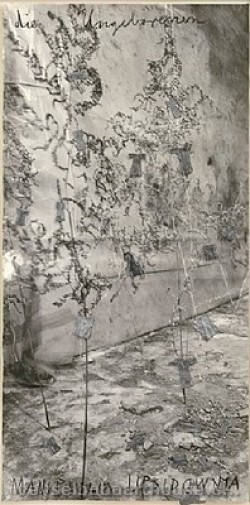
Anselm Kiefer
Anselm Kiefer (born 8 March 1945) is a German painter and sculptor. He studied with Joseph Beuys and Peter Dreher during the 1970s. His works incorporate materials such as straw, ash, clay, lead, and shellac. The poems of Paul Celan have played a role in developing Kiefer's themes of German history and the horror of the Holocaust, as have the spiritual concepts of Kabbalah.
In his entire body of work, Kiefer argues with the past and addresses taboo and controversial issues from recent history. Themes from Nazi rule are particularly reflected in his work; for instance, the painting "Margarethe" (oil and straw on canvas) was inspired by Paul Celan's well-known poem "Todesfuge" ("Death Fugue").
His works are characterised by an unflinching willingness to confront his culture's dark past, and unrealised potential, in works that are often done on a large, confrontational scale well suited to the subjects. It is also characteristic of his work to find signatures and/or names of people of historical importance, legendary figures or historical places. All of these are encoded sigils through which Kiefer seeks to process the past; this has resulted in his work being linked with the movements New Symbolism and Neo–Expressionism.[2]
Kiefer has lived and worked in France since 1992. Since 2008, he has lived and worked primarily in Paris[3] and in Alcácer do Sal, Portugal.[4]
Early life and career
The son of a German art teacher,[5] Kiefer was born in Donaueschingen two months before the end of World War II. In 1951, his family moved to Ottersdorf, and he attended public school in Rastatt, graduating high school in 1965. He entered University of Freiburg, and studied pre-Law and Romance languages. However, after 3 semesters he switched to Art, studying at Art academies in Freiburg, Karlsruhe, and Düsseldorf. In Karlsruhe, he studied under Peter Dreher, an important realist and figurative painter.[6] He received an Art degree in 1969.[2]
Kiefer moved to Dusseldorf in 1970. In 1971 he moved to Hornbach, in southwestern Germany, where he established a studio. He remained there until 1992; his output during this first creative time is known at The German Years. In 1992 he relocated to France.
Work
Photography
Kiefer began his career as a photographer with performances in which he, in paramilitary costume, mimicked the Nazi salute on various locations in France, Switzerland and Italy calling for Germans to remember and to acknowledge the loss to their culture through the mad xenophobia of the Third Reich. In 1969, at Galerie am Kaiserplatz, Karlsruhe, he presented his first single exhibition "Besetzungen (Occupations)" with a series of photographs about controversial political actions.
Painting and sculpture
Kiefer is best known for his paintings, which have grown increasingly large in scale with additions of lead, broken glass, and dried flowers or plants, resulting in encrusted surfaces and thick layers of impasto.[7]
By 1970, while studying informally under Joseph Beuys at Kunstakademie Düsseldorf,[8] his stylistic leanings resembled Georg Baselitz's approach. He worked with glass, straw, wood and plant parts. The use of these materials meant that his art works became temporary and fragile, as Kiefer himself was well aware; he also wanted to showcase the materials in such a way that they were not disguised and could be represented in their natural form. The fragility of his work contrasts with the stark subject matter in his paintings. This use of familiar materials to express ideas was influenced by Beuys, who used fat and carpet felt in his works. It is also typical of the Neo-Expressionist style.
Kiefer returned to the area of his birthplace in 1971. In the years that followed, he incorporated German mythology in particular in his work, and in the next decade he argued with the Kabbalah. He went on extended journeys throughout Europe, the USA and the Middle East; the latter two journeys further influenced his work. Besides paintings, Kiefer created sculptures, watercolors, woodcuts, and photographs.
Throughout the 1970s and early 1980s, Kiefer made numerous paintings, watercolors, woodcuts, and books on themes interpreted by Richard Wagner in his four-opera cycle Der Ring des Nibelungen (The Ring of the Nibelung).[9] In the early 1980s, he created more than thirty paintings, painted photographs, and watercolors that refer in their titles and inscriptions to the Romanian Jewish writer Paul Celan's poem "Todesfuge" ("Death Fugue").[10]
A series of paintings which Kiefer executed between 1980 and 1983 depict looming stone edifices, referring to famous examples of National Socialist architecture, particularly buildings designed by Albert Speer and Wilhelm Kreis. The grand plaza in To the Unknown Painter (1983) specifically refers to the outdoor courtyard of Hitler's Chancellery in Berlin, designed by Speer in 1938 in honor of the Unknown Soldier.[11] In 1984–85, he made a series of works on paper incorporating manipulated black-and-white photographs of desolate landscapes with utility poles and power lines. Such works, like Heavy Cloud (1985), were an indirect response to the controversy in West Germany in the early 1980s about NATO's stationing of tactical nuclear missiles on German soil and the placement of nuclear fuel processing facilities.[12]
By the mid-1980s, Kiefer’s themes widened from a focus on Germany's role in civilisation to the fate of art and culture in general. His work became more sculptural and involved not only national identity and collective memory, but also occult symbolism, theology and mysticism. The theme of all the work is the trauma experienced by entire societies, and the continual rebirth and renewal in life. During the 1980s his paintings became more physical, and featured unusual textures and materials.[13] The range of his themes broadened to include references to ancient Hebrew and Egyptian history, as in the large painting Osiris and Isis (1985–87). His paintings of the 1990s, in particular, explore the universal myths of existence and meaning rather than those of national identity.[14] From 1995 to 2001, he produced a cycle of large paintings of the cosmos.[15] He also started to turn to sculpture, although lead still remains his preferred medium.
Since 2002, Kiefer has worked with concrete, creating the towers destined for the Pirelli warehouses in Milan, the series of tributes to Velimir Khlebnikov (paintings of the sea, with boats and an array of leaden objects, 2004-5), a return to the work of Paul Celan[16] with a series of paintings featuring rune motifs (2004–6), and other sculptures.[17] In 2006, Kiefer’s exhibition, Velimir Chlebnikov, was first shown in a small studio near Barjac, then moved to White Cube in London, then finishing in the Aldrich Contemporary Art Museum in Connecticut. The work consists of 30 large (2 x 3 meters) paintings, hanging in two banks of 15 on facing walls of an expressly constructed corrugated steel building that mimics the studio in which they were created. The work refers to the eccentric theories of the Russian futurist philosopher/poet Velimir Chlebnikov, who invented a "language of the future" called "Zaum", and who postulated that cataclysmic sea battles shift the course of history once every 317 years. In his paintings, Kiefer’s toy-like battleships—misshapen, battered, rusted and hanging by twisted wires—are cast about by paint and plaster waves. The work’s recurrent color notes are black, white, gray, and rust; and their surfaces are rough and slathered with paint, plaster, mud and clay.[18]
In 2009 Kiefer mounted two exhibitions at the White Cube gallery in London. A series of forest diptychs and triptychs enclosed in glass vitrines, many filled with dense Moroccan thorns, was titled Karfunkelfee, a term from German Romanticism stemming from a poem by the post-war Austrian writer Ingeborg Bachmann. In The Fertile Crescent, Kiefer presented a group of epic paintings inspired by a trip to India fifteen years earlier where he first encountered rural brick factories. Over the past decade the photographs which Kiefer took in India "reverberated" in his mind to suggest a vast array of cultural and historical references, reaching from the first human civilization of Mesopotamia to the ruins of Germany in the aftermath of the Second World War, where he played as a boy. "Anyone in search of a resonant meditation on the instability of built grandeur", wrote the historian Simon Schama in his catalogue essay, "would do well to look hard at Kiefer’s The Fertile Crescent".[19]
In Morgenthau Plan (2012), the gallery is filled with a sculpture of a golden wheat field, enclosed in a five-meter-high steel cage.[20]
Books
Beginning in 1969 Kiefer also worked on book design. Early examples are typically worked-over photographs; his more recent books consist of sheets of lead layered with paint, minerals, or dried plant matter. For example, he assembled numerous lead books on steel shelves in libraries, as symbols of the stored, discarded knowledge of history.[21] The book Rhine (1981) comprises a sequence of 25 woodcuts that suggest a journey along the Rhine River; the river is central to Germany's geographical and historical development, acquiring an almost mythic significance in works such as Wagner's Ring of the Nibelungs. Scenes of the unspoiled river are interrupted by dark, swirling pages that represent the sinking of the battleship Bismarck in 1941, during an Atlantic sortie codenamed Rhine Exercise.
Other projects
In 2009, Kiefer directed and designed the sets for Am Anfang (In the Beginning) by Jörg Widmann at the Opéra National de Paris.[22]
Studios
Kiefer's first studio was his home in Hornbach, a large converted brick factory.[23] In 1991 he left Hornback to spend time traveling in Japan, Mexico and India.[24] In 1992 he established himself in Barjac, France, where he transformed his 35-hectare studio compound La Ribaute into a Gesamtkunstwerk. A derelict silk factory,[25] his studio is enormous and in many ways is a comment on industrialization. He created there an extensive system of glass buildings, archives, installations, storerooms for materials and paintings, subterranean chambers and corridors.
Sophie Fiennes filmed Kiefer's studio complex in Barjac for her documentary study, Over Your Cities Grass Will Grow (2010), which recorded both the environment and the artist at work. One critic wrote of the film: "Building almost from the ground up in a derelict silk factory, Kiefer devised an artistic project extending over acres: miles of corridors, huge studio spaces with ambitious landscape paintings and sculptures that correspond to monumental constructions in the surrounding woodland, and serpentine excavated labyrinths with great earthy columns that resemble stalagmites or termite mounds. Nowhere is it clear where the finished product definitively stands; perhaps it is all work in progress, a monumental concept-art organism."[26]
During 2008, Kiefer left his studio complex at Barjac and moved to Paris. A fleet of 110 lorries transported his work to a warehouse on the Périphérique in Croissy-Beaubourg, outside Paris, that had once been the depository for the La Samaritaine department store.[27][28] A journalist wrote of Kiefer's abandoned studio complex: "He left behind the great work of Barjac – the art and buildings. A caretaker looks after it. Uninhabited, it quietly waits for nature to take over, because, as we know, over our cities grass will grow."[29] In December 2011, Kiefer acquired the Mülheim-Kärlich Nuclear Power Plant, a decommissioned reactor near Koblenz.[30]
Exhibitions
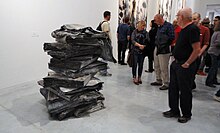
In 1969, Kiefer had his first solo exhibition, at Galerie am Kaiserplatz in Karlsruhe. Along with Georg Baselitz, he represented Germany at the Venice Biennale in 1980. He was also featured in the 1997 Venice Biennale with a one-man show held at the Museo Correr, concentrating on paintings and books.[31]
Comprehensive solo exhibitions of Kiefer's work have been organized by the Kunsthalle Düsseldorf (1984); Art Institute of Chicago (1987); Sezon Museum of Art in Tokyo (1993); Neue Nationalgalerie in Berlin (1991); Metropolitan Museum of Art in New York (1998); Fondation Beyeler in Basel (2001); the Modern Art Museum of Fort Worth (2005); the Hirshhorn Museum and Sculpture Garden in Washington D.C. (2006); the San Francisco Museum of Modern Art and the Guggenheim Museum Bilbao (2007).[15] In 2007, the Guggenheim Museum Bilbao presented an extensive survey of recent work. Several of his works were exhibited in 2009 for the first time in the Balearic Islands, in the museum Es Baluard in Palma de Mallorca. In 2012, the Art Gallery of Hamilton presented some of his paintings.[32] London's Royal Academy of Arts mounted the first British retrospective of the artist's work in September 2014.[33]
In 2007 Kiefer was commissioned to create a huge site-specific installation of sculptures and paintings for the inaugural "Monumenta" at the Grand Palais, Paris.[34] With the unveiling of a triptych – the mural Athanor and the two sculptures Danae and Hortus Conclusus – at the Louvre in 2007, Kiefer became the first living artist to create a permanent site-specific installation in the museum since Georges Braque in 1953.[35]
In 2008, Kiefer installed Palmsonntag (Palm Sunday) (2006), a monumental palm tree and 36 steel-and-glass reliquary tablets in the auditorium-gym of the First Baptist Church of Los Angeles, an enormous Spanish Gothic edifice built in 1927. The room was reconfigured to accommodate the work. Floors were sanded to remove the basketball court's markings, and the wall for the reliquary paintings was constructed inside the space.[36] In 2010 the piece was installed at the Art Gallery of Ontario museum in Toronto, where Kiefer created eight new panels specifically for the AGO's exhibition of this work.
In Next Year in Jerusalem (2010) at Gagosian Gallery, Kiefer explained that each of the works was a reaction to a personal "shock" initiated by something he had recently heard of.[37]
Collections
Kiefer's works are included in numerous public collections, including the Hamburger Bahnhof, Berlin; the Museum of Modern Art and the Solomon R. Guggenheim Museum, New York; the Collezione Maramotti, Reggio Emilia, Italy; Detroit Institute of Arts, Detroit; the Tate Modern, London; the San Francisco Museum of Modern Art; the Art Gallery of Ontario, Toronto; the Albright-Knox Art Gallery, Buffalo; the Philadelphia Museum of Art; the National Gallery of Australia, Canberra; the Tel Aviv Museum of Art; and the Albertina, Vienna. The Metropolitan Museum of Art in New York owns 20 of the artist’s rare watercolors. Notable private collectors include Eli Broad and Andrew J. Hall.[38]
Recognition
In 1990, Kiefer was awarded the Wolf Prize. In 1999 the Japan Art Association awarded him the Praemium Imperiale for his lifetime achievements. In the explanatory statement it reads:
"A complex critical engagement with history runs through Anselm Kiefer's work. His paintings as well as the sculptures of Georg Baselitz created an uproar at the 1980 Venice Biennale: the viewers had to decide whether the apparent Nazi motifs were meant ironically or whether the works were meant to convey actual fascist ideas. Kiefer worked with the conviction that art could heal a traumatized nation and a vexed, divided world. He created epic paintings on giant canvases that called up the history of German culture with the help of depictions of figures such as Richard Wagner or Goethe, thus continuing the historical tradition of painting as a medium of addressing the world. Only a few contemporary artists have such a pronounced sense of art's duty to engage the past and the ethical questions of the present, and are in the position to express the possibility of the absolution of guilt through human effort."
In 2008, Kiefer was awarded the Peace Prize of the German Book Trade, given for the first time to a visual artist. Art historian Werner Spies said in his speech that Kiefer is a passionate reader who takes impulses from literature for his work.[39] In 2011 Kiefer was appointed to the chair of creativity in art at the Collège de France.
- 1983 Hans-Thoma-Preis (Baden-Württemberg)
- 1990 Wolf Prize in Arts
- 1990 Goslarer Kaiserring
- 1997 International Prize by the Jury of the 47th Venice Biennale
- 1999 Praemium Imperiale (Japan)
- 2005 Merit Cross 1st Class of the Order of Merit of the Federal Republic of Germany (Verdienstkreuz 1. Klasse)
- 2005 Austrian Decoration for Science and Art[40]
- 2008 Peace Prize of the German Book Trade
- 2011 Berliner Bär (B.Z.-Kulturpreis)
- 2011 Leo-Baeck-Medal, Leo Baeck Institut of New York
Art market
In 2011, Christie's set a new worldwide record of $3.6 million for the artist, when it sold To the Unknown Painter (1983) to an American private collector.[38]
Kiefer is represented by Yvon Lambert Gallery[41] in Paris, Gagosian Gallery in New York, White Cube in London and Thaddaeus Ropac[42] in Paris and Salzburg. Before moving to Gagosian, he showed with Marian Goodman Gallery, New York.[43]
Personal life
Kiefer left his first wife and children in Germany on his move to Barjac in 1992. Since 2008 he has lived in Paris, in a large house in the Marais district, with his second wife, the Austrian photographer Renate Graf, and their two children.[44]
See also
- Holocaust memorial landscapes in Germany
Biography, criticism, catalogues, monographs, documentaries
- Alteveer, Ian. “Anselm Kiefer (born 1945).” In Heilbrunn Timeline of Art History. New York: The Metropolitan Museum of Art, 2000–. (October 2008)
- Danto, Arthur. in "Anselm Kiefer". Encounter and Reflections: Art in the Historical Present. New York: Farrar Strauss Grioux, 1990
- Auping, Michael. Anselm Kiefer: Heaven and Earth catalogue for exhibition of the same name, Modern Art Museum of Fort Worth, 2005. Munich: Preston, 2005
- Andréa Lauterwein: Anselm Kiefer / Paul Celan. Myth, Mourning and Memory. With 157 illustrations, 140 in colour. London: Thames & Hudson, 2007, ISBN 978-0-500-23836-3
- Fiennes, Sophie. Over Your Cities Grass Will Grow. Documentary film. 105 min. France, Netherlands, Great Britain, 2010
- Biro, Matthew. Anselm Kiefer and the Philosophy of Martin Heidegger, University of Michigan, 2000
- Biro, Matthew. Anselm Kiefer: Phaidon Focus, University of Michigan, 2013
